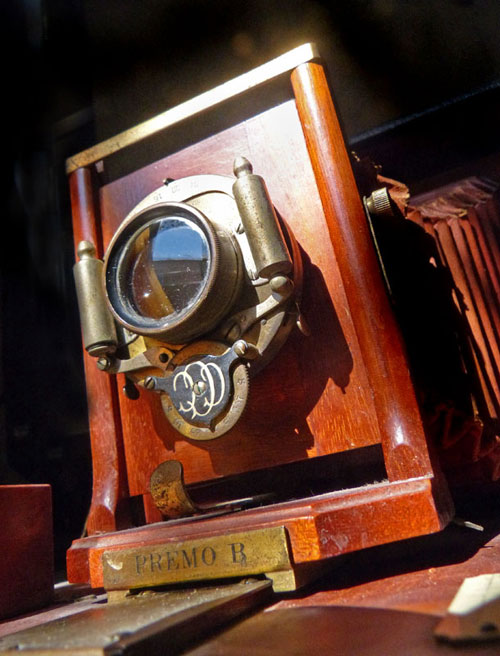Steampunk Cameras: From Jules Verne’s Anachronistic “Camera-Phone” to the Pentacon Six and Voigtlander Vitessa
posted Wednesday, April 18, 2012 at 5:06 PM EDT
 AMIENS, FRANCE — Literary scholars announced that they have unearthed a 33-page handwritten manuscript of "Le Telephon-Photographique," ("The Camera-Phone") an unpublished short story by the father of science fiction, Jules Verne.
AMIENS, FRANCE — Literary scholars announced that they have unearthed a 33-page handwritten manuscript of "Le Telephon-Photographique," ("The Camera-Phone") an unpublished short story by the father of science fiction, Jules Verne.
Written in 1874, this story of a hand-held communications and picture-taking device that leads to social upheaval in 21st-century France provides yet another example of Verne's celebrated prescience.
"The discovery of this highly prophetic work is exciting in both a literary and a social context," said Jean-Michel Frelseien of the Ecole-Polytechnique. "Verne's view of a 21st-century Paris overrun by camera-phone-toting nabobs is indeed dismal."
Okay, this sounds amazing. Unfortunately it adapted from a fake article that appeared in that bastion of journalism, the satirical publication, The Onion, back in 2004.
Nonetheless, given Verne’s track record of predicting developments like the nuclear powered submarine and journeys to the moon, a tale about a Victorian era camera phone sounds plausible. Ironically, there are artists today who are actually making 19th century camera phones. They are part of the "steampunk" movement.
 What is steampunk? Well, here is how science fiction writer Scott Westefeld describes it, "Steampunk is like a snapshot from the last moment in human history when technology was intelligible to the layman. The Internet is global and seemingly omniscient and iPads and phones are microscopic workings encased in plastic blobjects.”
What is steampunk? Well, here is how science fiction writer Scott Westefeld describes it, "Steampunk is like a snapshot from the last moment in human history when technology was intelligible to the layman. The Internet is global and seemingly omniscient and iPads and phones are microscopic workings encased in plastic blobjects.”
"Compare that to a steam engine, where you can watch the pistons move and feel the heat of its boilers. I think we miss that visceral appeal of the machine."
Movies like Terry Gilliam’s "Brazil" and David Lynch’s "Dune" are representative of the steampunk vision, blending advanced futuristic technology with Victorian age steam powered machines.
The Northwest is the hot bed of steampunk culture and every year in the Seattle area, enthusiasts gather for a "Steamcon" convention (www.steamcon.org). According to Steamcon co-founder Diana Vick, a Seattle illustrator, the idea steampunk is, "We want to go back to when technology was ornate and interesting and understandable."
Prominent among those technologies are cameras and at the Steamcon they are lovingly displayed.
Some, such as Ken Patton's sculpture-like "Time Lapse Camera" -- a old spring wound clock attached to a Lumix FZ35 as a timer -- are more art object than working tools. However, there are also tables full of collections of older film cameras that fit the Vick’s description of ornate, interesting, and understandable.
Topping the list of steampunk favorites is the Pentacon Six and cameras like the Voigtlander Vitessa (below), a camera with a unique push plunger film advance I once owned.

Among these steampunk cameras, I was surprised to discover a 1894 Kodak Premo B (below), like the one on my office bookcase. With its brass shutter pistons, wood frame and long leather bellows, it is very ornate and elegant. Now all I have to do is figure out how to mount my Lumix G1 inside it to make my own steampunk camera.
What I like about the strange and odd cameras I have reported on the last few weeks is that they allow us to dream a little, to imagine what a camera could be rather than simply accepting that they must be just "blobjects" of plastic and metal.
